Related Research Articles

Harold Roy Ballin was an American football player and coach. He played at the tackle position for Princeton University from 1912 to 1914 and was a consensus first-team All-American in both 1913 and 1914. Ballin served as the head football coach at Duquesne University from 1922 to 1923, compiling a record of 4–12. He was inducted into the College Football Hall of Fame as a player in 1973.
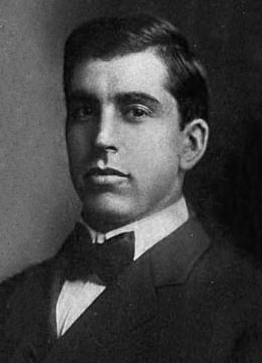
Clarence John "Pike" Kenney was an American college football player and coach. He played college football at Marquette University before transferring as a medical student to the Saint Louis University. Kenney was an outstanding halfback and captain of the 1906 Saint Louis Blue and White football team when his teammate, Bradbury Robinson, completed the first legal forward pass to Jack Schneider in the history of American football on September 5 against Carroll in Waukesha, Wisconsin. Kenney served as head football coach at Creighton University in 1908, where his team went 3–3–2. He returned to Marquette in 1910 as an assistant coach and served as the head football coach there for one season in 1912, compiling a record of 3–4.

The 1912 Army Cadets football team was an American football team that represented the United States Military Academy as an independent during the 1912 college football season. Under head coach Ernest Graves Sr., the Cadets compiled a 5–3 record and outscored opponents by a total of 108 to 59. The Cadets lost to a one-loss Yale team, a strong Carlisle Indians team led by 1912 decathlon gold medalist Jim Thorpe, and to Navy in the annual Army–Navy Game.

The 1925 Army Cadets football team was an American football team that represented the United States Military Academy as an independent during the 1925 college football season. In its third season under head coach John McEwan, the team compiled a 7–2 record and outscored opponents by a total of 185 to 71.
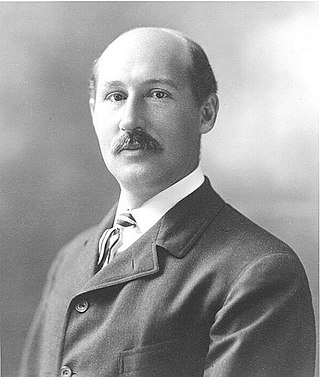
The 1913 College Football All-America team is composed of college football players who were selected as All-Americans for the 1913 college football season. The only two selectors who have been recognized as "official" selectors by the National Collegiate Athletic Association (NCAA) for the 1913 season are Walter Camp and the International News Service (INS). Camp's All-America Team was published in Collier's Weekly. The INS was founded in 1909 by William Randolph Hearst, and its sports editor Frank G. Menke selected the INS All-America team. Other sports writers, newspapers, coaches selecting All-America teams in 1913 included Harper's Weekly, Fielding H. Yost, and Parke H. Davis.
The 1922 College Football All-America team is composed of college football players who were selected as All-Americans by various organizations and writers that chose College Football All-America Teams in 1922. The only selector recognized by the NCAA as "official" for the 1922 season is Walter Camp, whose selections were published in Collier's Weekly. Additional selectors who chose All-American teams in 1922 included: Athletic World magazine, selected by 214 coaches; Norman E. Brown, sports editor of the Central Press Association; the New York Tribune, selected by Ray McCarthy with advice from Grantland Rice and William B. Hanna; Walter Eckersall, of the Chicago Tribune; Frank G. Menke; and Billy Evans, who polled 200 sports editors.
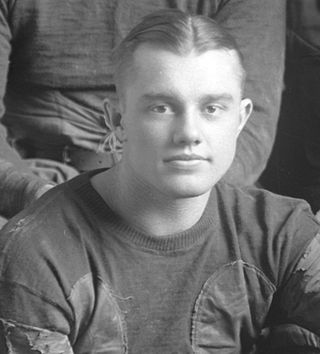
Irwin Charles "Utz" Uteritz was an American athlete and coach. He played American football and baseball for the University of Michigan from 1921 to 1923. At 140 pounds, he was one of the lightest quarterbacks ever to start for a major college program. Despite his size, Michigan football coach Fielding H. Yost called him "the best field general I ever had." Uteritz led Michigan to back-to-back undefeated seasons and a national championship in 1923. He also played three years of baseball for Michigan at second base and shortstop, hit above .300 and was elected as captain of the 1923 baseball team. Uteritz later served as a football and baseball coach at Northwestern University (1924–1925), the University of Wisconsin (1925–1935), the University of California (1935–1947), and Washington University in St. Louis (1947–1963).
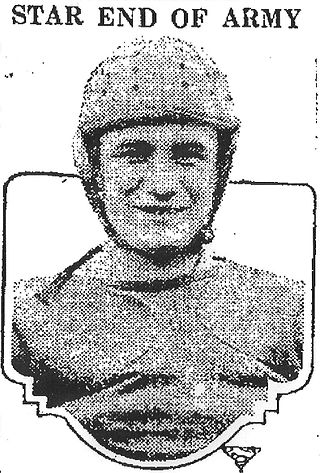
Louis Alfred "Merry" Merrilat (Merillat), Jr. was an American football end and military officer. He played college football with Army and was selected as a first-team All-American in both 1913 and 1914. He was wounded in battle while serving in France during World War I and later played in the National Football League for the Canton Bulldogs in the 1925 NFL season. He became a soldier of fortune, training Iran's Persian Guard, working with the Chinese Army in the 1930s, and serving in the French Foreign Legion.

The 1923 Wisconsin Badgers football team was an American football team that represented the University of Wisconsin in the 1923 Big Ten Conference football season. The team compiled a 3–3–1 record, finished in seventh place in the Big Ten Conference, and outscored its opponents by a combined total of 89 to 32. John J. Ryan was in his first year as Wisconsin's head coach.
Charles Chauncey Buell was an American football player and educator.
Lloyd A. "Butch" Pixley was an American football player. A native of Columbus, Ohio, he played college football for the Ohio State Buckeyes at the guard position in 1918, 1919, 1921, and 1922.

The 1914 Illinois Fighting Illini football team was an American football team that represented the University of Illinois in the Western Conference during the 1914 college football season. In their second season under head coach Robert Zuppke, the Fighting Illini compiled a 7–0 record, shut out four of seven opponents, and outscored all opponents by a total of 224 to 22.

The 1922 Army Cadets football team represented the United States Military Academy in the 1922 college football season. In their eighth season under head coach Charles Dudley Daly, the Cadets compiled a 8–0–2 record, shut out seven of their ten opponents, and outscored all opponents by a combined total of 228 to 27, an average of 22.8 points scored and 2.7 points allowed. In the annual Army–Navy Game, the Cadets defeated the Midshipmen 17–14.

The 1913 Army Cadets football team represented the United States Military Academy in the 1913 college football season. In their first season under head coach Charles Dudley Daly, the Cadets compiled an 8–1 record, shut out five of their nine opponents, and outscored all opponents by a combined total of 253 to 57 – an average of 28.1 points scored and 6.3 points allowed. The Cadets' only loss was against Notre Dame by a 35 to 13 score. In the annual Army–Navy Game at the Polo Grounds in New York City, the Cadets won 22–9.

The 1920 Army Cadets football team represented the United States Military Academy in the 1920 college football season. In their sixth season under head coach Charles Dudley Daly, the Cadets compiled a 7–2 record, shut out five of their nine opponents, and outscored all opponents by a combined total of 314 to 47. In the annual Army–Navy Game, the Cadets lost to the Midshipmen 7–0. The Cadets also defeated Lebanon Valley College 53–0 and Bowdoin College 90–0.

The 1921 Army Cadets football team Represented the United States Military Academy in the 1921 college football season. In their seventh season under head coach Charles Dudley Daly, the Cadets compiled a 6–4 record, shut out five of their ten opponents, and outscored all opponents by a combined total of 217 to 65. In the annual Army–Navy Game, the Cadets lost to the Midshipmen 7–0. The Cadets also lost to Yale and Notre Dame.
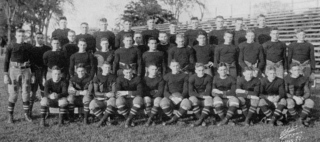
The 1923 Army Cadets football team represented the United States Military Academy in the 1923 college football season. In their first season under head coach John McEwan, the Cadets compiled a 6–2–1 record, shut out five of their nine opponents, and outscored all opponents by a combined total of 237 to 56. In the annual Army–Navy Game, the Cadets and Midshipmen played to a scoreless tie at the Polo Grounds in New York City.

The 1926 Army Cadets football team represented the United States Military Academy in the 1926 college football season. In their first season under head coach Biff Jones, the Cadets compiled a 7–1–1 record, shut out four of their nine opponents, and outscored all opponents by a combined total of 240 to 71. In the annual Army–Navy Game, the Cadets tied the Midshipmen at 21. The team's only loss came to Notre Dame by a 7 to 0 score. The team was ranked No. 11 in the nation in the Dickinson System ratings released in December 1926.
The 1927 Army Cadets football team represented the United States Military Academy in the 1927 college football season. In their second season under head coach Biff Jones, the Cadets compiled a 9–1 record, shut out six of their ten opponents, and outscored all opponents by a combined total of 197 to 37. In the annual Army–Navy Game, the Cadets defeated the Midshipmen 14–9. The team's only loss came to national champion Yale by a 10 to 6 score. The team was ranked No. 6 in the nation in the Dickinson System ratings released in December 1927.
The 1914 University of New Mexico football team was an American football team that represented the University of New Mexico as an independent during the 1914 college football season. In its fourth season under head coach Ralph Hutchinson, the team compiled a 3–1–1 record and outscored opponents by a total of 77 to 33. Halfback Fred "Fritz" Calkins was the team captain.
References
- ↑ "Fritz Breidster Is New Army Leader". The Washington Herald. November 28, 1921. p. 6 – via Newspapers.com.
- ↑ "Army Captain Plays Star Game at Tackle". The Richmond Item. November 7, 1922. p. 5 – via Newspapers.com.
- ↑ "Some Team!". The Lima News. December 13, 1922.
- ↑ "All-American Eleven Composed from Stars of Ten Institutions". Salt Lake Tribune. December 24, 1922.
- ↑ Frank G. Menke (December 11, 1922). "All-American Grid Selections". The Lincoln Star.
- ↑ Billy Evans (December 13, 1922). "Big Ten Given Eleven Places on Honor Roll: Kirk, Kirke and Goebel Named". The Lima News.
- ↑ "Fritz Breidster to join 'Hall'". Manitowoc Herald-Times. February 8, 1979. p. 20 – via Newspapers.com.
- ↑ "Retired 32nd commander dies". The Capital Times. April 5, 1982. p. 28 – via Newspapers.com.